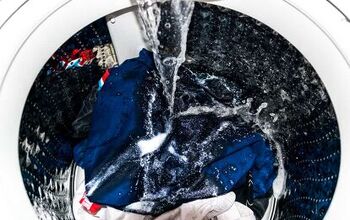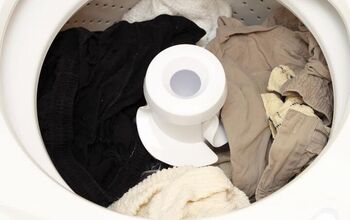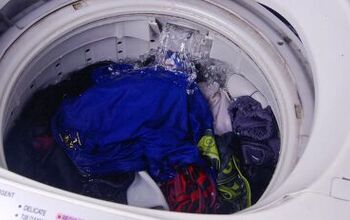Whirlpool Washer Agitates But Won't Spin? (Fix It Now!)

It’s frustrating when you finally have a day off, and you’re trying to catch up on laundry only to find out that your Whirlpool washer won’t spin even though it’s agitating. Now, you’re stuck with sopping wet, clean clothes that you must wring out by hand before transferring to the dryer.
If your Whirlpool washer agitates but won’t spin, this may be a sign that there is a signal malfunction in your machine. The problem could be an uneven load or an uneven washer. It could also mean the switch is stuck, the drain is clogged, or that the washer is uneven.
There’s nothing more annoying than a washer that decides it doesn’t want to spin at the end of its cycle even though it agitates. We’ve created this guide to assist you in diagnosing what may be wrong with your Whirlpool washer. Also, we’ve included a few simple fixes for these issues so that you can apply them and see if it makes any difference. Let’s get started!
Do You Need Appliance Installation or Replacement?
Get free, zero-commitment quotes from pro contractors near you.

Why Is My Whirlpool Washer Not Spinning Even Though It Agitates?
There are many different reasons that your washer may not be spinning. Some of the fixes are simple and easy to do yourself, while others require hiring a handyman. Below, we’ve included several issues and the easy fixes you can apply to see if it helps your washer enter the spin cycle.
Blockage In The Drain System
Sometimes we forget things in our pockets, such as pennies and dimes or tissue. Or perhaps some buttons popped off a blouse or a pair of jeans. Regardless of what it is, the object can make its way into the hoses that connect the drain pump to the washer. This blockage will prevent your washer from spinning.
You can usually access the drain pump on the back near the floor. Some models will have it under the back of the washer, so you will need to detach the machine. Before doing this, however, you should unplug the appliance.
Read your manual for your specific Whirlpool machine. You will need to remove any clamps that keep the hose in place so that you can clear any clogs. Then, reattach it, plug your machine in and try to run it on the spin cycle.
Unbalanced Laundry Load
One of the most common causes of a failed spin cycle is an unbalanced laundry load. If your materials have clung to one side of the drum, this will cause the motion of the washer to be thrown off. This is especially common when you’re washing bulky items such as winter jackets or large blankets.
If you have a newer machine, then it may not reach a high enough speed on the spin cycle to wring your clothes and drain the washer if the load is unbalanced. By rearranging your wet laundry and placing it evenly in your washer, you may fix the problem.
Power Source Came Unplugged
Sometimes, the most straightforward scenarios can be overlooked, which is why you should double-check that your washer is plugged in. If you left while in the middle of your cycle and returned to sopping wet clothes, a vibration could have unplugged the washer from the wall.
If the washer is still plugged in, check the breaker panel to ensure that you didn’t trip a breaker. This is worth looking into, as it happens a lot more often than one would think.
Washer Is Using An Extension Cord For Power
The power cord for your washer is too heavy-duty to be placed into an extension cord. Therefore, there should be a direct connection between your washing machine and outlet. The issue lies within the extension cord, as it’s not powerful enough to run the motor for the washer. In fact, it could cause overheating and the appliance to shut off before the spin cycle.
To fix this, try plugging your washer directly into a wall outlet and see if that makes a difference. Regardless if it does or doesn’t, you should refrain from using an extension cord with your washer. Not only does it shorten the lifespan of your washer, but it can also cause burnout and fires.
Uneven Washer
If your washer tends to shake on the spin cycle, which is quite common among the older models, then your washer may be off-balance. Any vibration or extra noise while it’s running is an indication that your washer is off-kilter.
In the event that it is uneven, you can adjust each of the washer’s legs until it’s completely level. To check that it’s level, you can use a laser level or a water level on top of the washer. Once it’s even, try rerunning the washer to see if it enters the spin cycle.
Spin Switch Is Malfunctioning
If you have a top-loading Whirlpool washer, there is a small button under the lid. The lid presses the switch when the lid is closed so that the washer can tell the cover is shut. However, if this button is bent, it won’t trigger as it is supposed to.
To test the switch, you will need to open the lid and select the spin cycle. Then, press the button and start the washer. If the machine starts spinning, then you will need to bend the button back into place. However, if the washer didn’t spin, you will want to replace the switch as this means the switch is faulty.
Using The Wrong Detergent For A HE Front Load Whirlpool Washer
Owning a high-efficiency front load washer means that you also need to use a high-efficiency detergent because they have low foaming action. If you don’t, then the other detergents produce suds that signal your washer that the load is too large. This will keep your washer from spinning correctly.
Drive Belt Needs To Be Replaced
A drive belt that has come off the pulley wheel or one that is broken will allow the machine to agitate, but it won’t allow it to enter the spin cycle. You may hear the spin cycle kick in, and the washer might still drain, but the drum won’t budge.
To check the drive belt, you will need to get into the back of your washer, so unplug your machine before doing so. Then, remove the back of the washer and see if the belt has fallen off the pulley or check if the belt is broken. If it fell off, you will need to put it back. However, it will need to be replaced if it’s broken.
Drain Hose Is Kinked
A kinked hose will stop water from flowing away from the appliance, which means that your washer will not drain all the way or enter its spin cycle. To fix this, you can pull the washer out from its place to look at the hose behind it. Ensure that the hose is free of any kinks or sharp bends, then put the washer back in place.
If the hose is kinked, simply unkink it by moving the hose around. When you push the washer back, make sure you don’t scrunch up the hose. Then, run your washer on the spin cycle to see if it drains the remaining water and beings the spin cycle.
When To Call A Professional
Sometimes, there are issues with your washer that you cannot fix on your own. If you’ve tried everything listed above, but you cannot get your washer to spin, then you may want to call in a professional for assistance.
Bad Motor
If your motor isn’t running, this could keep your washer from spinning. Some Whirlpool models have carbon brushes that can sustain wear and tear over time, and they’re cheap to replace. Although, the issue could be something more than just worn carbon brushes.
If you have an induction type of motor in your washer, you can still sustain an electric shock even if your washer is unplugged. Therefore, it’s crucial that you allow a professional to test your motor to see if this is the problem, instead of doing this by yourself.
Drain Pump Needs To Be Replaced
If your washer isn’t spinning, then you might have a faulty drain pump. To see if this is the problem, you can check the continuity using a multimeter on the drain pump’s motor connections. If they’re not viable, then this means you need a handyman to come in and replace the part.
Do You Need Appliance Installation or Replacement?
Get free, zero-commitment quotes from pro contractors near you.

Wrapping It Up
Having a washer that won’t spin, but agitates fine, can be extremely frustrating. However, before you stress out, check for the problems listed above, as it could be a simple fix. If you’ve tried everything, and your washer still isn’t spinning, it might be time to call in a professional. Expect to pay between $50 and $200 depending on the cause of the problem. However, if the cost of repair is half of the price of your washer, or your washer is old, it might be a good idea to replace the whole thing instead.
Related Guides

Heather is a passionate writer who loves anything DIY. Growing up, she learned everything from home repairs to design, and wants to share her tips with you. When she's not writing, she's usually hiking or searching for her next DIY project.
More by Heather Robbins



























